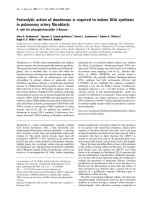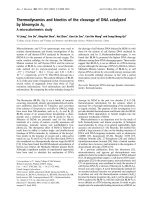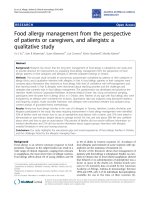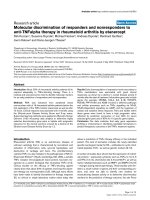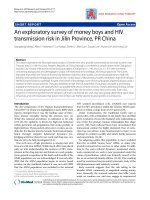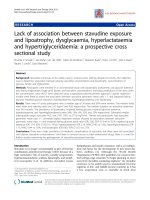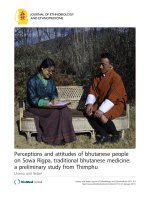Báo cáo y học: "Childhood physical abnormalities following paternal exposure to sulfur mustard gas in Iran: a case-control study" pot
Bạn đang xem bản rút gọn của tài liệu. Xem và tải ngay bản đầy đủ của tài liệu tại đây (233.79 KB, 6 trang )
RESEARC H Open Access
Childhood physical abnormalities following
paternal exposure to sulfur mustard gas
in Iran: a case-control study
Hassan Abolghasemi
1
, Mohammad H Radfar
2*
, Mehdi Rambod
3
, Parvin Salehi
1
, Hossein Ghofrani
1
,
Mohammad R Soroush
4
, Farahnaz Falahaty
1
, Yousef Tavakolifar
1
, Ali Sadaghianifar
1
, Seyyed M Khademolhosseini
1
,
Zohreh Kavehmanesh
1
, Michel Joffres
5
, Frederick M Burkle Jr
6
, Edward J Mills
7
Abstract
Background: Mustard gas, a known chemical weapon, was used during the Iran-Iraq war of 1980-1988. We aimed
to determine if exposure to mustard gas among men was significantly associated with abnormalities and disorders
among progenies.
Methods: Using a case-control design, we identified all progenies of Sardasht men (exposed group, n = 498), who
were born at least nine months after the exposure, compared to age-matched controls in Rabat, a nearby city
(non-exposed group, n = 689). We conducted a thorough medical history, physical examination, and appropriate
paraclinical studies to detect any physical abnormality and/or disorder. Given the presence of correlated data, we
applied Generalized Estimating Equation (GEE) multivariable models to determine associations.
Results: The overall frequency of detected physical abnormalities and disorders was significantly higher in the
exposed group (19% vs. 11%, Odds Ratio [OR] 1.93, 95% Confidence Interval [CI], 1.37-2.72, P = 0.0002). This was
consistent across sexes. Congenital anomalies (OR 3.54, 95% CI, 1.58-7.93, P = 0.002) and asthma (OR, 3.12, 95% CI,
1.43-6.80, P = 0.004) were most commonly associated with exposure. No single abnormality was associated with
paternal exposure to mustard gas.
Conclusion: Our study demonstrates a generational effect of exposure to mustard gas. The lasting effects of
mustard gas exposure in parents effects fertility and may impact child health and development in the long-term.
Introduction
Sulfur mustard gas [bis(2-chloroethyl)sulfide], first
synthesized in early 1800 s, has been used in several
major wars, and is a common chemical warfare agent
[1]. Ira qi forces used it against civilian populations dur-
ing the 1980-1988 Iran-Iraq war [2,3].
Although mustard gas can have severe systemic effects
on humans [1], it is best known as a skin vesicant. In a
series of approximately 34,000 Iranian patients exposed
to mustard gas, the lungs, eye, and skin were the most
common sites of injury, in order of the greatest preva-
lence [4,5].
Beside its acute effects, mustard gas has a number of
known long-term effects on various body organs such as
lung, stomach, bone marrow, and gonads [6-11]. In
addition, sulfur mustard has been shown to influence
the reproductive function in both animals and human
being [9,12-14]. It is a potent carcinogen and mutagen
[15]. However, there is little info rma tion abo ut parental
exposure to sulfur mustard and congenital anomalies in
the offspring.
We aimed to estimate the frequency of physical
abnormalities and disorders among the progenies of
men in a major urban setting (Sardasht City) exposed to
sulfur mustard gas. We aimed to compare the preva-
lence of observed abnormalit ies and disorders wit h
those of a non-exposed population.
* Correspondence:
2
Urology & Nephrology Research Center, Shahid Beheshti University of
Medical Sciences 9th Boostan Street, Pasdaran Avenue, Tehran, Iran
Abolghasemi et al. Conflict and Health 2010, 4:13
/>© 2010 Abolghasemi et al; licensee BioMed Central Ltd. This is an Open Access article distributed under the terms of the Creative
Commons Attribution License ( which permits unrestri cted use, distribution, and
reprodu ction in any medium, provided the original work is properly cited.
Methods
Subjects and setting
We began this study in 2004, about 17 years after the che-
mical a ttack in Sardasht. We followed children up to
March 2009. Sardasht is a western Iranian city that was
chemically bombarded with sulfur mustard gas (HD) by
Iraqi forces on June 28, 1987. Documents maint ained by
military and civil authorities in Sardasht region confirm
that approximately 8025 inhabitants were exposed to mus-
tard gas and approximately 4500 people received medical
treatment. Of these, records confirming early clinical man-
ifestations of exposure and subsequent medical complica-
tions were available for 735 male survivors [9].
All Sardasht men that had a confirmed h istory of
mustard gas exposure were selected and their progenies,
who were born at least nine months after the exposure
were considered as the exposed group. However, chil-
dren whose both parents had confirmed history of expo-
sure to mustard gas were not included in this study.
Since Iraqi forces attacked Iranian soldiers and civi-
lians with various chemical agents several times, a spe-
cial commission was assigned by Veteran Affairs
Organization to confirm the chemical exposure and to
determine the severity of injury. This commission con-
sisted of a pulmonologist, a dermatologist, a neurologist,
and an ophthalmologist that based their decision on
hospital documents, mustard gas exposure stigmata, and
clinical signs and symptoms of chronic complicati ons of
exposure, and appropriate paraclinical studies as
required for diagnostic confirmation. All Sardasht men
studied had official confirmation of chemical exposure
from this commission. These patients were contacted
using the Veteran Affairs Organization’s database and
by placing signposts and billboards across the city.
Control population
Rabat is a nearby city that has ethnic, cultur al, and geo-
grap hical characteristics similar to Sardasht but was not
exposed to chemical attack. Rabat is 20 Km from Sar-
dasht, and according to governmental documents, no
proven traces of chemical agents were found in the
Rabat region. There is no difference in access to medical
care between the two regions. In this study, 164 couples
from Sardasht were frequency matched by age with 136
couplesfromanexistingcohortfromRabat.Theinitial
groups were larger due to differences in the age distri-
bution, we used a random number table to remove ran-
domly several cases and controls to obtain a similar
distribution of individuals in each age group.
Data Collection
We developed an interview sheet and a checklist as
data-gathering tools. Our data collection included
demographic data of all chemically injured males and
their spouses in the exposed (Sardasht) group, age,
occupation, educational level, date of marriage; close
relative marriage, and any history of chemical injury.
The same data was also gathered from the non-exposed
(Rabat) group.
Trained general practitioners (GPs) evaluated medical
histories from all progenies born at least nine months
after the date of the chemical expo sure in both exposed
and non-exposed groups. In addition, the GPs per-
formed a complete physical examinat ion. If any physical
abnormality or special diso rder was suspected, the pro-
geny was referred to a pediatrician to confirm the diag-
nosis. If the pediatrician considered additional
diagnostic tools necessary for confirmation, paraclinical
studies (e.g. echocardiography, spirometry, various ima-
ging techniques) were performed.
Based on these examinat ions and confi rmatory paracli-
nical studies, various abnormalities were identified and
recorded. All abnormality entities were coded based on
International Classification of Diseases, revision 10 (ICD-
10) and/or disorders were classified as follows: diseases of
the blood; endocrine, nutritional and metabolic diseases;
mental and behavioral disorders; diseases of the nervous
system and epilepsy; diseases of the eye, adnexa, ear and
mastoid process; diseases of the circulatory system; dis-
eases of the respiratory system; diseases of the digestive
system; diseases of the musculoskeletal system; diseases
of the genitourinary system; and congenital malforma-
tions. Whenever any disagreement occurred betwe en the
diagnostic opinion of GPs and the pediatrician, the pedia-
tric diagnosis was acce pted. In addi tion, if a progeny had
a history of physical abnormality and disorder based on
medical rec ords but had normal physical exam at the
time of the present study, due to previous medical treat-
ment or surgical management,theywereincludedasan
event. Physical abnormalities or disorders were defined
as any abnormality that can be detected by medical his-
tory, physical exam, or paraclinical studies.
Our sample size estimation was based on 95% power,
atwo-sidedalpha(0.01),andanexpecteddifferenceof
10% with a continuity correction. We provide descrip-
tive statistics on the populations as groups. To take into
account the correlation between families, we used SAS
GENMOD procedure (SAS 9.2 SAS, Gary, NC),
assumed a binomial distribution, logit link f unction and
an exchangeable correlation matrix type We provide
point estimates as Odds Ratios (ORs) with 95% Confi-
dence Intervals (CIs). We used 2-sided P-values.
Results
Two hundred and eighty-three couples had official con-
firmation of exposure to Sulfur Mustard gas. Of these,
Abolghasemi et al. Conflict and Health 2010, 4:13
/>Page 2 of 6
in 193 couples only the male partner was chemically
injured at least nine months before conception. Nine-
teen of these men were infertile (primary infertility in
12 men); of the seven men with secondary infertility five
men had become infertile after the exposure; one was
infertilebeforeexposureandthedataofthelastone
was not available. Ten were older than 65 years at expo-
sure. Therefore, this study included 164 couples as
designated exposed group. The non-exposed group, also,
consisted of 136 age-matched couples. General charac-
teristics of exposed and non-exposed groups are sum-
marized in Table 1.
Of a total number of 498 progenies born at least nine
months after chemical attack in the exposed group,
291 (58%) were males (male/female ratio: 1:1.40). In
Rabat, 689 child ren were born at least nine months after
the date of Sardasht bombardment; 350 (50%) were
males (male/female ratio: 1:1.03). Children in the non-
exposed group were slightly older than their counterparts
in the exposed group (10.6 standard deviation (SD)
4.7 years and 9.0 SD 4.7 years, respectively, P = < 0.0001).
In both groups, the minimum child’ sagewas0.1year
and maximum age 16 years.
Based on the medical history, physical examination,
and paraclinical studies, a comparative listing of
abnormalities was prepared between the exposed and
non-exposed groups. This list and related ICD-10 cod-
ing is provided in Table 2. In addition, the numbers
of progenies whose abnormality was confirmed by medi-
cal history but were partially or completely normal at
the time of physical examination because of prior
medical intervention were 32 (6.4%) and 20 (2.8%) in
the exposed and non-exposed groups, respectively
(P = 0.19).
In the exposed and non-exposed groups, 120 (24%)
and 52 (7.5%) patients were referred to the pediatrician
for further investigation and confirmation of diagnosis.
After this second-level assessment, the overall frequency
of evaluated abnormalities and disorders in the exposed
group was significantly higher than the non- exposed
group (95 [19%] vs. 77 [11%]; 1.93, 1.37-2.72, P < 0.001).
According to the ICD-10 coding, 20 (4%) patients in
the exposed group had respiratory diseases (“J ” group)
and 21 (4%) congenital malformations (“ Q” group),
respectively; while both these figures were 9 (1%) in the
non-exposed group. Frequency of respiratory diseases
(OR, 3.12, 95% CI, 1.43-6.80, P = 0.004) and congenital
malformations (OR 3.54, 1.58-7.93, P=0.002) were sig-
nificantly higher in the exposed group than in the non-
exposed (See Table 2).
Discussion
Our study found that the overall fre quency of physical
abnormalities is significantly associated with children
whose fathers were exposed to mustard gas. Further-
more, there was a significant association between pater-
nal exposure to mustard gas and both respiratory
dis eases and congenital malformations. Given the wide-
spread use of mustard gas i n wartime, the lasting effects
may potentially last generations.
Animal and human studies indicate that paternal
exposure to certain agents can result in developmental
Table 1 General characteristics of exposed (Sardasht) and non-exposed (Rabat) couples at the time of study
Exposed (Sardasht)
N = 164
Non- exposed (Rabat)
N = 136
P-Value
Age (years)
Males 45.9 (8.3) 44.4 (8.1) 0.14
Females 40.6 (8.7) 49.3 (14.9) 0.0001
Duration of marriage 20.5 (8.0) 23.6 (8.8) 0.002
Close relative marriage 7.3% (N = 12) 14.7% (N = 20) 0.04
Education level (female partner)
Illiterate 14.0% (N = 23) 86.8% (N = 118) 0.0001
Elementary 26.2% (N = 43) 10.3% (N = 14)
High School 17.1% (N = 28) 0.7% (N = 1)
Some or more college 42.7% (N = 70) 2.2% (N = 3)
Number of Children
Males 291 (58%) 350 (51%) 0.009
Females 207 (42%) 339 (49%)
Total 498 689
Average number of children per father 35
Average number of brothers 1.7 1.5 0.01
Average number of sisters 1.6 1.7 0.6
Data are prese nted as mean standard deviation (SD) or proportion (%).
Abolghasemi et al. Conflict and Health 2010, 4:13
/>Page 3 of 6
abnormalities in progenies [16]. Several studies demon-
strated that exposure of male rats and mice to cyclopho-
sphamide can lead to congenital malformations in
progenies [17 ,18]. In humans, pater nal exposure to var-
ious agents such as acrylamide, lead, and solvents result
in an increase in congenital malformations [19-21].
A mechanism suggested for the effect of paternal pre-
conception exposure is the occurrence of transmissible
genetic changes or an epigenetic mechanism [22-24].
Possible explanation of findings
Sulfur mustard is a cytotoxic agent with mutagenic and
carcinogenic effects [15]. Its active i ntermediate, sulfo-
nium ion, reacts rapidly with proteins and nucleic acids,
alters chemical functional groups such as amines, car-
boxyls, phosphates, S-H, and O-H groups, and produces
alkylation products. This process may result in cross-
linking between adjacent strands of DNA, which has
been shown to be extremely lethal to cells [6];
Confirmed effects of sulfur mustard gas on spermato-
genesis may explain the observed overall increase in
physical abnormalities among the progenies of chemical
victims [2,12,25,26]. However, few studies, previously
performed, were conclusive in determining a causal rela-
tionship. Pour-Jafari et al. [27] studied the rate of conge-
nital malformations among progenies and their parents
Table 2 List of physical abnormalities and disorders and
their ICD-10 coding found in the progenies of males
exposed and non-exposed to mustard gas
Condition* ICD
Coding
Exposed
(Sardasht)
(n = 498)
Non-
exposed
(Rabat)
(n = 689)
Endocrine, Nutritional and Metabolic
Diseases
E
Group
Hyperthyroidism E 05 1 0
Addison’s disease E 27.1 1 1
Total
Mental and Behavioral Disorders F
Group
Mental retardation F 70 4 0
Diseases of the Nervous System G
Group
Epilepsy G 40 0 1
Muscular dystrophy G 71.0 0 1
Cerebral Palsy G80 6 3
Total
Diseases of the Eye, Adnexa, Ear and
Mastoid Process
H
Group
Ambliopia H 53.0 0 1
Strabismus H 50 1 3
Ptosis H 02.4 0 2
Congenital nistagmus H 55 1 0
Hearing loss H 90 1 1
Total 3 7
Diseases of the Circulatory System I/R
Group
Rheumatic fever with heart
involvement
I01 1 1
Mitral valve prolapse I 34.1 3 0
Arrhythmias I 49 6 1
Cardiac murmur R1 11 3
Total
Diseases of the Respiratory System J
Group
Asthma J 45 20 9
Total 20 9
Diseases of the Digestive System K
Group
Inguinal hernia K 40 11 18
Umbilical hernia K 42 1 0
Diaphragmatic hernia K 44 1 0
Total 13 18
Diseases of the Musculoskeletal
System and Connective Tissue
M
Group
02
Torticollis M 43.6 0 2
Total
Diseases of the Genitourinary System N
Group
Pyelonephritis N 11 16 13
Nephrolithiasis N 20.0 2 3
Total 18 16
Table 2 List of physical abnormalities and disorders and
their ICD-10 coding found in the progenies of males
exposed and non-exposed to mustard gas (Continued)
Congenital Malformations Q
group
Microcephaly Q 02 1 1
Congenital cardiac disease Q 21 1 1
Ventricular septal defect Q 21.0 1 0
Tetralogy of Fallot Q 21.3 1 0
Aortic stenosis Q 23.0 1 0
Cleft palate Q 35 0 1
Bicornate uterus Q51. 1 0
Retractile/Undescended testis Q 55.2 4 2
Congenital dislocation of hip Q 65.0 1 1
Club foot Q 66.0 4 0
Flat foot Q 66.5 1 0
Congenital musculoskeletal
deformities of head, face, spine
and chest
Q67 1 0
Pectus excavatum Q 67.6 1 2
Phocomelia Q73 2 0
Congenital malformation of
knee
Q74.1 3 0
Total 23 8
Total 99 67
*Children may present with more than one condition
Abolghasemi et al. Conflict and Health 2010, 4:13
/>Page 4 of 6
of Iranian victims before and after chemical warfare
exposure and found that the rate of major malforma-
tions has increased from 33 per 1000 to 258 per 1000.
Although they had used his cases as their own contro ls,
and thus reduced selection bias, they did not adjust for
the effect of parents’ inc reasing age on malformation
occurrence. Taher et al[28] claimed that the use of mus-
tard gas in the Iran-Iraq conflict might have increased
the number of cleft lip and cleft palate in children, how-
ever, they were not able to establish any causal effect
between these two events, nor could they exclude the
effects of other possible causes.
Strengths & Limitations
Strengths of our study include its sample size and locally
relevant controls. Sardasht is one of the rare instances in
the world with a l arge population of mustard gas vic-
tims. Despite initial resistance to studying the effects of
exposure, overtime, initial politico-ethical resistance has
faded. No similar study has yet been performed with
this population. Furthermore, presence of an unexposed
population in a nearby city (Rabat) with characteristics
similar to the exposed group provided a unique oppor-
tunity to further strengthen this analysis. An inherent
limitation of studies like this, where the participants
may consider probable benefits by over- reporting
adverse outcomes, and also where a long time is passed
from the date of the event under investigation, is the
possibility of recall bias. We aimed to minimize these
biases by an inclusive physical exam and appropriate
paraclinical studies performed by GPs and further con-
firmation by a pediatrician. However, our exposed group
included only the progenies of those exposed males who
were present in the city at the time of study. Moreover,
we do not know the number of men exposed that died
or moved since exposure. We used clinical examination
and parac linical tests of liv e birth children to determine
disorders and malformations. It is possible that kariotyp-
ing and other genetic studies could have revealed more
problems [25,29]. It is also possible that miscarriages or
abortions would have yielded differing effects. Finally, it
is possible that our control population differs impor-
tantly from the exposed population that we have not
recognized. This issue exists with any non-randomized
comparison and we are unable to overcome this
concern.
Our stud y found a si gnificant association between
exposure to mustard gas and common disorders and
malformations. We did not find that any specific disor-
der or malformation was associated with exposure. We
expected this as, with anencephaly, for example, ther e is
aprevalencerateofaboutonein1000livebirths[1],
thus, even with a doubling of risk rates, a much greater
population would need to be studied to reveal strong
association with chemical exposure. Considering the
high number of chemical victims in Ir an, this study may
catalyze further comprehensive assessments with larger
study populations. Using a post hoc sample size calcula-
tion, we find that our study had greater than 95% power
to detect malformatio ns and greater than 99% power to
detect malformations/disorders.
We evaluated all clinical disorders and malformations,
regardless of hypothesis driven associati ons with chemi-
cal exposure. Our reasoning for this is that the link
between genetic disorders and resulting ill nesses is not
yet completely understood. So, for example, while rheu-
matic fever with congenital involvement may be most
often associated with communicable disease genesi s, we
cannot rule out that parental chemical exposure may be
associated with predispositions to certain illnesses [30].
Interpretation
Our study found a signifi cant association between over-
all frequency of physical abnormalities and disorders
and paternal exposure to mustard gas. Given the consid-
erable victims of mustard gas among Iranian civilians
and military personnel, as well as civilians and military
in other conflicts, the effects of war may have a lasting
and important effect on generations to come.
Ethical statement
The Board of Research Ethics in the Janbazan Medical
and Engineering Research Center (JMERC) and Shahed
University approved this study. Informed written con-
sent was obtained from all the parents and caregivers
involved in this study.
Author details
1
Research Center for Chemical Injuries, Baqiyatollah Medical Sciences
University, Vanak Square, Tehran, Iran.
2
Urology & Nephrology Research
Center, Shahid Beheshti University of Medical Sciences 9th Boostan Street,
Pasdaran Avenue, Tehran, Iran.
3
Research Institute for Endocrine Sciences,
Shahid Beheshti University of Medical Sciences, Velenjak, Tehran, Iran.
4
Janbazan Medical and Engineering Research Center (JMERC), Chemical
Warfare Victims Research Unit, Velenjak, Tehran, Iran.
5
Faculty of Health
Sciences, Simon Fraser University, Burnaby, Canada.
6
Harvard Humanitarian
Initiative, Harvard School of Public Health, Harvard Universi ty, Boston, USA.
7
Interdisciplinary School of Health Sciences, Faculty of Health Sciences,
University of Ottawa, Ottawa, Canada.
Authors’ contributions
HA, MHR, MR, PS, HG, MRS, FF, YT, AS, SMK, ZK conceived the study. HA,
MHR, MR, PS, HG, MRS, FF, YT, AS, SMK, ZK designed and conducted the
data collection. HA, MHR, MR, PS, HG, MRS, FF, YT, AS, SMK, ZK, MJ, FMB, EJM
conducted data analysis. HA, MHR, MR, PS, HG, MRS, FF, YT, AS, SMK, ZK, MJ,
FMB, EJM wrote the drafts of the manuscript and approved the final
submitted version.
Competing interests
The authors declare that they have no competing interest s.
Received: 28 May 2010 Accepted: 14 July 2010 Published: 14 July 2010
Abolghasemi et al. Conflict and Health 2010, 4:13
/>Page 5 of 6
References
1. Aguiar MJ, Campos AS, Aguiar RA, Lana AM, Magalhaes RL, Babeto LT:
Neural tube defects and associated factors in liveborn and stillborn
infants]. J Pediatr (Rio J) 2003, 79:129-34.
2. Azizi F, Keshavarz A, Roshanzamir F, Nafarabadi M: Reproductive function
in men following exposure to chemical warfare with sulphur mustard.
Med War 1995, 11:34-44.
3. United Nations Security Council: Report of the mission dispatched by the
secretary-general to investigate allegations of the use of chemical
weapons in the conflict between the Islamic Republic of Iran and Iraq.
New York: United Nations 1987.
4. Donovan JW, MacLennan R, Adena M: Vietnam service and the risk of
congenital anomalies. A case-control study. Med J Aust 1984, 140:394-7.
5. Cowan DN, DeFraites RF, Gray GC, Goldenbaum MB, Wishik SM: The risk of
birth defects among children of Persian Gulf War veterans. N Engl J Med
1997, 336:1650-6.
6. Balali-Mood M, Navaeian A: Clinical and practical findings in 233 patients
with sulfur mustard poisoning. Proceedings of the 2nd World Congress on
New Compounds in Biological and Chemical Warfare: Toxicological Evaluation,
Industrial Chemical Disasters, Civil Protection and Treatment Ghent, Belgium,
State University of Ghent 1986.
7. Erickson JD, Mulinare J, McClain PW, et al: Vietnam veterans’ risks for
fathering babies with birth defects. JAMA 1984, 252:903-12.
8. Ghanei M, Fathi H, Mohammad MM, Aslani J, Nematizadeh F: Long-term
respiratory disorders of claimers with subclinical exposure to chemical
warfare agents. Inhal Toxicol 2004, 16:491-5.
9. Ghanei M, Rajaee M, Khateri S, Alaeddini F, Haines D: Assessment of
fertility among mustard-exposed residents of Sardasht, Iran: a historical
cohort study. Reprod Toxicol 2004, 18:635-9.
10. Heston W: Induction of pulmonary tumors in strain A mice with methyl
bis (beta-chloroethyl) amine hydrochloride. J Natl Cancer Inst 1949,
10:125-30.
11. Zarchi K, Akbar A, Naieni KH: Long-term pulmonary complications in
combatants exposed to mustard gas: a historical cohort study. Int J
Epidemiol 2004, 33:579-81.
12. Karalliedde L, Wheeler H, Maclehose R, Murray V: Possible immediate and
long-term health effects following exposure to chemical warfare agents.
Public Health 2000, 114:238-48.
13. Khateri S, Ghanei M, Keshavarz S, Soroush M, Haines D: Incidence of lung,
eye, and skin lesions as late complications in 34,000 Iranians with
wartime exposure to mustard agent. J Occup Environ Med 2003,
45:1136-43.
14. Sasser LB, Cushing JA, Dacre JC: Two-generation reproduction study of
sulfur mustard in rats. Reprod Toxicol 1996, 10:311-9.
15. Gross CL, Nealley EW, Nipwoda MT, Smith WJ: Pretreatment of human
epidermal keratinocytes with D, L-sulfuraphane protects against sulfur
mustard sytotoxicity. Cutan Ocul Toxicol 2006, 25:155-63.
16. Anderson D: Male-mediated developmental toxicity. Toxicol Appl
Pharmacol 2005, 207:506-13.
17. Jenkinson PC, Anderson D: Malformed foetuses and karyotype
abnormalities in the offspring of cyclophosphamide and allyl alcohol-
treated male rats. Mutat Res 1990, 229:173-84.
18. Jenkinson PC, Anderson D, Gangolli SD: Increased incidence of abnormal
foetuses in the offspring of cyclophosphamide-treated male mice. Mutat
Res 1987, 188:57-62.
19. Tornquist M, et al: Chem Res Toxicol 2002, 13:517-22.
20. Uzych L: Teratogenesis and mutagenesis associated with the exposure of
human males to lead: a review. Yale J Biol Med 1985, 58:9-17.
21. Brender JD, Suarez L: Paternal occupation and anencephaly. Am J
Epidemiol 1990, 131:517-21.
22. Mageroy N, Mollerlokken OJ, Riise T, Koefoed V, Moen BE: A higher risk of
congenital anomalies in the offspring of personnel who served aboard a
Norwegian missile torpedo boat. Occup Environ Med 2006, 63:92-7.
23. Kircher M, Brendel M: DNA alkylation by mustard gas in yeast strains of
different repair capacity. Chem Biol Interact 1983, 44:27-39.
24. Wormser U, Izrael M, Van der Zee EA, Brodsky B, Yanai J: A chick model for
the mechanisms of mustard gas neurobehavioral teratogenicity.
Neurotoxicol Teratol 2005, 27:65-71.
25. Rall DP, Pechura CM: Effects on health of mustard gas. Nature 1993,
366:398-9.
26. Safarinejad MR: Testicular effect of mustard gas. Urology 2001, 58:90-4.
27. Pour-Jafari H: Congenital malformations in the progenies of Iranian
chemical victims. Vet Hum Toxicol 1994, 36:562-3.
28. Taher AA: Cleft lip and palate in Tehran. Cleft Palate Craniofac J 1992,
29:15-6.
29. Watson AP, Jones TD, Griffin GD: Sulfur mustard as a carcinogen:
application of relative potency analysis to the chemical warfare agents
H, HD, and HT. Regul Toxicol Pharmacol 1989,
10:1-25.
30. Nayar S, Nayar PG, Cherian KM: Heart valve structure: a predisposing
factor for rheumatic heart disease. Heart 2006, 92:1151-2.
doi:10.1186/1752-1505-4-13
Cite this article as: Abolghasemi et al.: Childho od physical abnormalities
following paternal exposure to sulfur mustard gas in Iran: a case-
control study. Conflict and Health 2010 4:13.
Submit your next manuscript to BioMed Central
and take full advantage of:
• Convenient online submission
• Thorough peer review
• No space constraints or color figure charges
• Immediate publication on acceptance
• Inclusion in PubMed, CAS, Scopus and Google Scholar
• Research which is freely available for redistribution
Submit your manuscript at
www.biomedcentral.com/submit
Abolghasemi et al. Conflict and Health 2010, 4:13
/>Page 6 of 6
